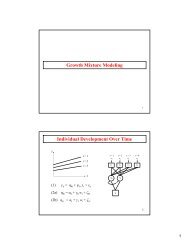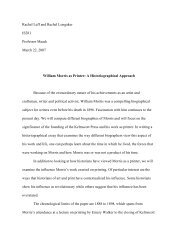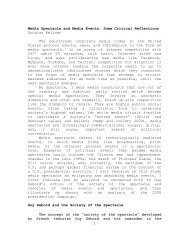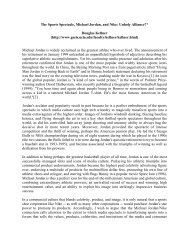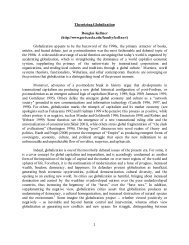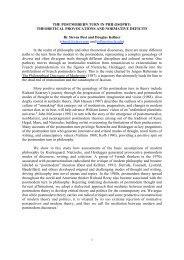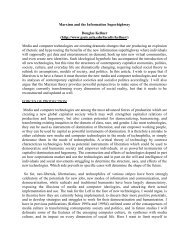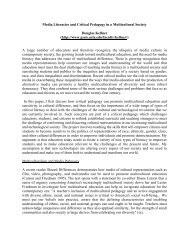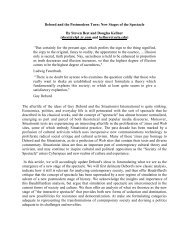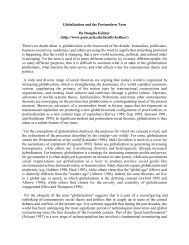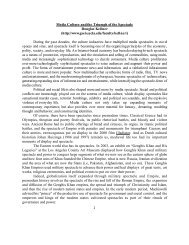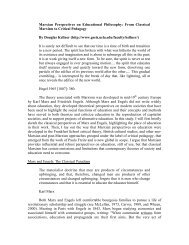Rap, Black Rage, and Racial Difference Steven Best and ... - UCLA
Rap, Black Rage, and Racial Difference Steven Best and ... - UCLA
Rap, Black Rage, and Racial Difference Steven Best and ... - UCLA
Create successful ePaper yourself
Turn your PDF publications into a flip-book with our unique Google optimized e-Paper software.
In the mid-1990s, spectacular feuds between East <strong>and</strong> West coast rap groups broke out with<br />
highly publicized shoot outs <strong>and</strong> the murder of Tupac <strong>and</strong> The Notorious B.I.G. Following the<br />
bizarre ruptures of divisions between art <strong>and</strong> life in G-rap, with the artists living <strong>and</strong> dying the<br />
violent scenarios they were performing, [2] a movement to stop the violence, to heal the rifts<br />
between East <strong>and</strong> West, emerged as did what became know as "New School," or "Now School,"<br />
building on <strong>and</strong> going beyond the sounds of the "Old School" (now interpreted largely as the first<br />
wave of East Coast rap but in some genealogies including early gangster like N.W.A.). New<br />
York groups like De La Soul <strong>and</strong> The Fugees produced less harsh rhythms, more affirmative <strong>and</strong><br />
romantic lyrics, <strong>and</strong> new fusions with Soul, R&B, <strong>and</strong> pop. Wyclef Jean <strong>and</strong> Lauryn Hill spun<br />
off the Fugees to create their own megahits <strong>and</strong> the multiple Grammies, including best album of<br />
the year, won by The Miseducation of Lauryn Hill in 1999 showed that rap had matured, entered<br />
the mainstream, <strong>and</strong> gained recognition as an significant musical idiom. [3]<br />
Thus, today, rap covers a large spectrum, ranging from the urban fury of gangster rap to the<br />
rural fusion of blues <strong>and</strong> rap in Arrested Development, to the educated raps about black history<br />
of Chuck D, to the poetic <strong>and</strong> political discourses of the Disposable Heroes of Hiphoprisy, to the<br />
G-funk melodies of Snoop Doggy Dogg <strong>and</strong> celebrations of thug life by the late Tupac Shakur. It<br />
is therefore a mistake to identify the genre of rap per se with its most extreme expressions such<br />
as gangsta rap, as there are countless varieties of urban rap, suburban rap, rural rap, rap <strong>and</strong> soul<br />
fusions, reggae rap, Latino rap, white rap, <strong>and</strong> even Christian rap groups, so the genre is highly<br />
flexible <strong>and</strong> can be used for a variety of purposes.<br />
Yet it is gangster rap, G-funk, or what we'll call "G-rap" that is still the cornerstone of rap's<br />
billion dollar plus market, an authentic voice of organic hip hop culture, <strong>and</strong> probably the genre<br />
that elevated rap to the global popular. G-rap provided a distinctive language, style, <strong>and</strong> attitude<br />
that made rap a significant oppositional form <strong>and</strong> subject of intense controversy. While breakdancing,<br />
graffiti, <strong>and</strong> other forms of hip hop have declined in significance, rap <strong>and</strong> the hip hop<br />
style enshrined in rap performance <strong>and</strong> music video have become a highly significant part of<br />
contemporary culture. Hence, our study below will focus on G-rap, saving engagement with<br />
other important rap <strong>and</strong> hip hop forms for later work.<br />
G-<strong>Rap</strong> from Gangster to Funk<br />
Much rap music provides a spectacle of self-assertion with images of black rap singers<br />
threatening white power structures, denouncing racial oppression <strong>and</strong> police violence, <strong>and</strong><br />
celebrating a diverse realm of black cultural forms extending from Afrocentric nationalism to the<br />
gangster lifestyle. With its staccato beat, multilayered sound, aggressive lyrics, in-your-face<br />
messages, <strong>and</strong> defiant style, rap provides a spectacle of revolt <strong>and</strong> insurrection in its live<br />
performances, music videos, <strong>and</strong> recorded forms. Blasting out of boom boxes in the ghettos,<br />
roaring from car stereos, <strong>and</strong> blaring from home sound systems, rap provides a cascade of sounds<br />
threatening middle class order <strong>and</strong> decorum <strong>and</strong> the powers that be.<br />
Some rap singers cultivate the outlaw <strong>and</strong> rebel image through their clothes, their life-styles, <strong>and</strong><br />
in many cases their crimes, serving as a warning of the rage <strong>and</strong> violence seething in underclass<br />
ghetto communities. But other rap artists engage in political rap, or "conscious rap," seeing<br />
themselves as "knowledge warriors" <strong>and</strong> spokespeople for an oppressed underclass. "Organic




